Orange Fan Sponge
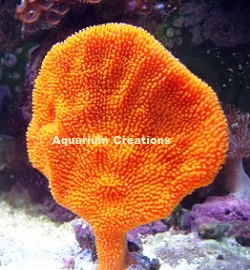
Description
A Fan sponge is naturally shaped like a Japanese hand held fan. They are natural suspension feeders,filtering food from the water. Phytoplankton foods bring outlot's of color. They are very helpful in filtering aquarium water.They can withstand a wide temperature variation and they last indefinitely in the marine aquarium.
Like other Sponges, the Orange Fan Sponge filter feeds plankton food from the ocean's water. Sponges can usually tolerate changesin water temperature with no ill effect. The Orange Fan Sponge requires moderate light and moderate water movement to survive. Many beginning hobbyists loose sponges because they do not provide enough light or food. The Orange Fan sponge's shape can vary quite a lot, but all pieces look unique and beautiful.
The most critical concern when receiving your sponge and placing it in your aquarium is that it can never be exposed to air. The air becomes trapped in the sponges channels that line the inside of the sponges body. With trapped air blocking the channels, the food has no pathway for the sponge to eat, which starves the sponge, ultimately killing the sponge.
Food & Supplements:
To keep your sponge healthy it will require supplemental feedings from any of the available liquid Plankton Foods and other foods made up of dissolved organics.
Level of Care:
Moderate
Approximate Purchase Size:
Small 1-1/2" to 3"; Medium 3" to 4"; Large 5" to 7"
|
Small$39.99
Medium $59.99
Large$99.99
|
Rasta Leather
Sinularis
Flexibillis

Also called Spaghetti leather
100's of
tentacles. Super long, super flowing, beautiful coloration
Description:A favorite from Fiji,
the best description for
the Spaghetti Finger Leather Coral is a finger type leather with
a large number of very long strands of leather. One of the favorite
leather corals for the aquarium, Spaghetti Leathers are golden-white
to green in color and have a highly branching form and are covered
in tiny polyps. These corals grow quickly and can quickly become
a showpiece after they are established. Larger specimens are
more "branchy" than smaller ones and make an impressive
display with pulsing water movement.
Tank Recommendations:When placing in your
aquarium, find a good spot and leave alone. Handle as little
as possible. Excessive handling can damage newly arrived specimens.
Once established, they are quite hardy, not as touchy as their
initial requirements sound. Spaghetti leathers do best in medium
to bright lighting. Moderately strong to strong water movement
is also important. The water
quality should be kept high with a fairly constant temperature
between 75 degrees and 80 degrees.
Feeding: Although the leather coral seeks
it's nutritional needs from more than one place, its main source
of energy comes from the minute algae zooxanthellae which supplies
the coral with a steady stream of energy and nutrients. A secondary
food source comes from the micro plankton and other filtered
foods that the leather coral traps in its tentacles during ocean
waves and currents. In the reef aquarium, the addition of bottled
trace elements such as iodine and strontium should supplement
the water to ensure good health.
Care Level:
Moderate
Approximate
shipping size: Small: 1"
to 2"; Medium 2" to 3"; Large 3-1/2" to 5";
Extra Large 5" to 8" |
Starting at $49.99
|
Pitoa
Island Neon Green Cabbage Leather
Sinularia brassica
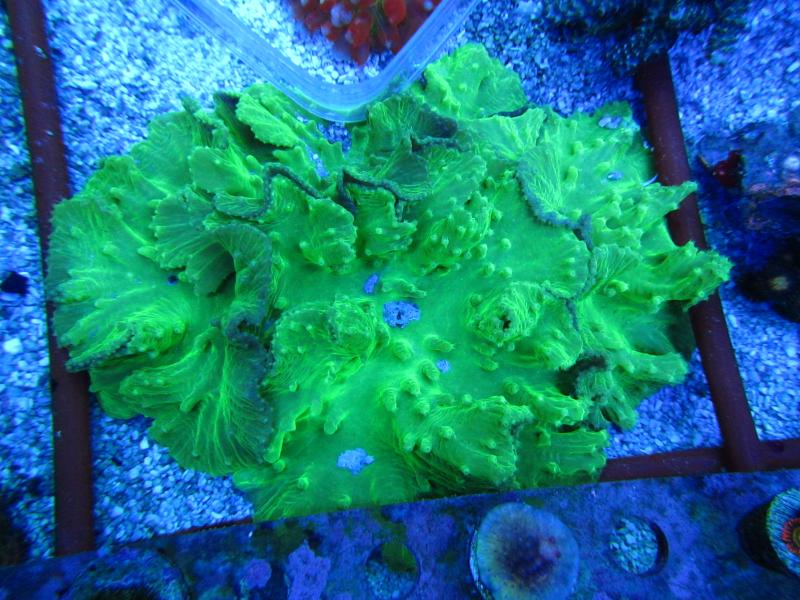
Description:The Neon Green Cabbage
Leather is one of the brightest leather corals available in the
aquarium trade. Its brilliant neon green coloration "Pops"
any where it's placed in the reef aquarium it will be a stunner.
Unlike the popular toadstool leather or finger leather corals
the Neon Green Cabbage Leather grows flat along the rock and
will continue to grow along the rock landscape it is placed on.
When the Neon Green Cabbage Leather is fully open you will see
numerous 1/16th of an inch polyps all along the leather. Just
like all leather corals, there will be periods where the cabbage
leather will not have polyps showing and will actually shed its
outer skin. This is a normal process leather corals of all types
go through. When the polyps return the Neon Green Cabbage Coral
will be larger and looking better than it did before! Once established
in your aquarium the Neon Cabbage Leather is easily propogated
by cutting pie shaped wedges with a sterile razor blade and letting
them heal and grow in the same reef aquarium they were originally
in..
Requirements The Neon Green Cabbage Leather requires moderate
to strong water flow. Lighting can be from moderate to high,
from Power Compacts, LED's and T5's to metal halides. We have
found they grow and look best under a lighting spectrum of between
14K to 20K.
Placement: You can mount the Neon
Green Cabbage Leather Coral using any IC Gel glue or marine putty
on any exposed rock or ledge in the middle of the reef aquarium
where it can recieve moderate water flow and moderate to high
lighting of the correct specturm. Leave some room around them
for growth so they do not intrude on another corals space. Make
sure that currents will be able to supply them with necessary
nutrients and trace elements. Leave an adequate distance between
the cabbage leather and neighboring corals, as they will expand
and grow and need the room.
Feeding: Although the leather coral seeks
it's nutritional needs from more than one place, its main source
of energy comes from the minute algae zooxanthellae which supplies
the coral with a steady stream of energy and nutrients. A secondary
food source comes from the micro plankton and other filtered
foods that the leather coral traps in its tentacles during ocean
waves and currents. In the reef aquarium, the secondary source
is from the addition of bottled zoo planktons, and other filter
foods and trace elements.
Approximate Purchase Size: Small:
1" to 2"; Medium: 2" to 3"; Large: 3"
to 4"
|
Small $49.99
Medium $74.99 Large $139.99
|
Extreme
Neon Green Green Polyping Toadstool Leather
Sarcophyton sp
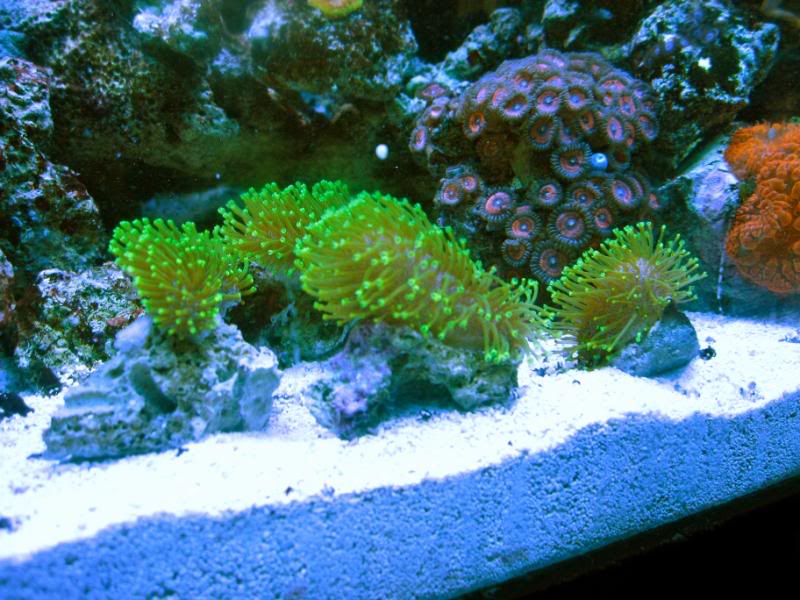
Description: The Extreme Neon Green
Polyping Leather Coral is one of our favorite corals. The polyps
on the Extreme are really large and it makes an amazing coral
for any reef aquarium. From beginners to advanced aquarists,
this is a favorite of many. It is easy to keep and propagate.This
leather coral is of the genus Sarcophyton Coral, also called
in more layman's term a Mushroom, Leather. Other names for this
easy to keep coral are Mushroom Leather Coral, Cup Leather Coral,
Toadstool, Umbrella Coral, and Mushroom Coral. Leather Corals
are generally easy to propagate in captivity by simply cutting
them into coral frags.
Requirements
Does best in medium to bright lighting and grow and look best
under a lighting spectrum of between 14K to 20K. Medium to strong
water movement is also important.
Feeding: Although the leather coral seeks
it's nutritional needs from more than one place, its main source
of energy comes from the minute algae zooxanthellae which supplies
the coral with a steady stream of energy and nutrients. A secondary
food source comes from the micro plankton and other filtered
foods that the leather coral traps in its tentacles during ocean
waves and currents. In the reef aquarium, the secondary source
is from the addition of bottled zoo planktons, and other filter
foods and trace elements.s iodine and strontium should supplement
the water to ensure good health.
Approximate
Purchase Size: 2"
to 3" |
$39.99
|
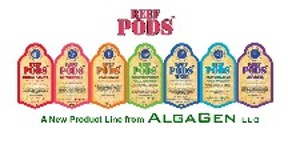
Reef Pods are the only truly tropical
live copepod cultures available on the market today.
Copepods (“Pods” in aquarium terms)
are a major component of the modern reef aquarium. Although,
pods often are accidently introduced via live rock placed in
reef aquariums, until recently there were few options available
to control and maintain copepod populations.
If lucky, aquarists would see swarms of these little white “bugs”
on the glass of their aquarium and subsequent feeding on these
bugs by the fish. Now, these beneficial bugs are recognized as
copepods and the methods for their colonization and proliferation
in aquariums is better understood.The addition and establishment
of copepod cultures to reef tanks is one of the best ways to
achieve a continuous self-generating food supply. Aquarists who
have established copepod populations know that most coral and
many other filter feeding invertebrates and small bottom feeding
fish such as Mandarins greatly benefit from copepods.
All of the AlgaGen ReefPods are tropical herbivorous species
of copepods that will survive in higher temperature tanks. Copepods
are an important energy source for reefs. Aquarists try to supply
that energy using frozen or preserved diets. Dead plankton is
not as nutritious as live plankton and food particles that are
not eaten foul water quality and add to nutrient levels. Non-living
food items do not swim about naturally and trigger feeding responses.
Professional and hobby aquarists, alike, now have the ability
to inoculate their systems with different copepod species at
will. They can experiment with different types and combinations
of pods for different types of feeders. Mandarins and Seahorses,
Anthias and Dragonettes, LPS Corals, deep water gorgonians, Acropora,
Crinoids, Basket Stars: the list of copepod lovers could go on
and on. |
|
ReefPods™ Tisbe
by AlgaGen
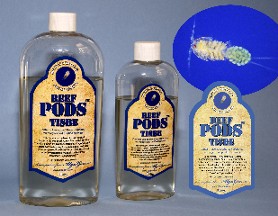
|
ReefPods™ Tisbe the most popular aquarium
Pod -they consumes your aquarium’s wastes and detritus,
reproduce well, and are food for a multitude of reef inhabitants!
ReefPods™ Tisbe is a live culture of the harpacticoid copepod
Tisbe biminiensis. Tisbe adult copepods live on bottom substrate
such as live rock or sand and will eat detritus and microalage
in the aquarium. They produce a small nauplii which is an excellent
food for aquarium filter feeders and fish larvae. The adults
are eaten by small bottom feeding fish such as gobies, dragonettes
and blennies. ReefPods™ Tisbe may be used as a starter culture
to add to marine aquarium refugiums or the main tank. Once established
they will reproduce quickly, growing from nauplii to adults in
about nine days. They will thrive in a wide range of aquarium
temperatures and a wide range of salinities. It is suggested
they be added to the aquarium at night or to the refugium to
avoid immediate fish predation.
Tisbe is an excellent all purpose aquarium
copepod owing to its role in the natural
environment as a detritivore. An opportunist feeder, Tisbe can
be used as a tank cleaner consuming uneaten food and wastes as
well as phytoplankton in the tank and refugium. Tisbe is capable
of producing many eggs during its adult life span that hatch
into nauplii which will enter the water column as food for your
filter feeding reef inhabitants and replenish the adult population
vital to tank hygiene. Tisbe adults and juveniles may also enter
the water column and be tasty and nutritious treats for your
reef fish! ReefPods are guaranteed to arrive alive but there
is no further guarantee after arrival.
Approximate copepod count: 8 oz bottles contain 100 to
200 pods and 16 oz bottles contain 200 to 300 pods. |
ReefPods™ Tisbe 8 ounce $13.99
|
PhycoPure
Reef Blend Phytoplankton
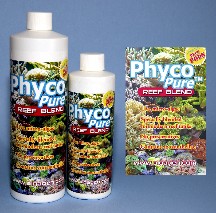
PhycoPure™ Reefblend is made of 7 different
types of LIVE microalgae as well as a dinoflagellate, zooxanthellae.
Reefblend was therefore created as a LIVE food supplement for
filter feeding marine aquarium inhabitants including the feeding
of existing copepod populations in the tank. It is grown in natural
seawater that has been ozonated, charcoal filtered and uv treated.
PhycoPure™ Reef Blend offers a wide range of particle sizes
and nutritional content that, individually, have been proven
very effective in various aquaculture farms, and projects. Just
like humans, animals require some level of variety in a food
source. It is understandable that no single food provides 100%
of the necessary nutrition required for good health. Hence the
blend of phytoplankton in PhycoPure™ Reef Blend
Aquarists have reported great results feeding PhycoPure Reef
Blend to Acropora (better polyp extension), all Euphyllia corals
(Torch, Elegance, Frogspawn, Hammer), Gorgonians, Chili corals,
Nephthea's, Carnation corals, Feather dusters, Tubeworms, Sponges,
Mushroom corals, Leather corals, all types of Brain corals, Montipora's,
Montastrea and Tubastrea species, and Certain anemones. |
|
Note: PhycoPure Reef Blend is guaranteed to arrive alive
but no guarantee beyond that is provided. |
Phycopure Reef Blend 8 ounce $11.95
Pycopure Reef Blend 16 ounce $19.95
|
Aquacultured Pulsing Xenia
Xenia elongata
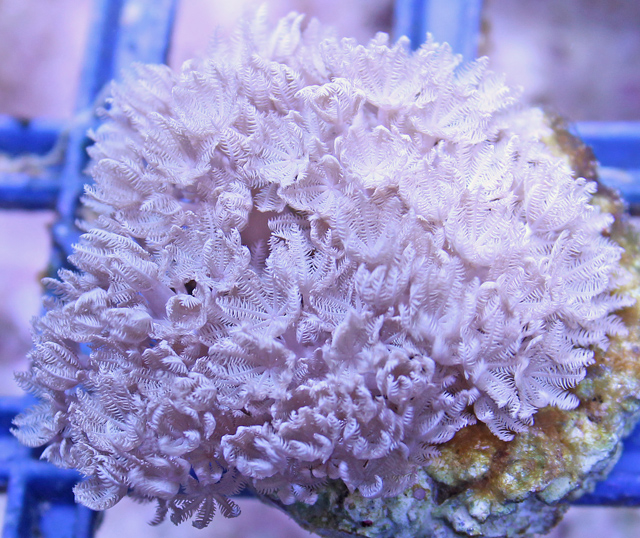
Description:
This easy to care for coral gets its name because of the rhythmic pulsing action of the coral polyps that look like a hand opening and closing. This activity, which is relatively uncommon among the sessile invertebrates we keep in the tank, is part of what makes this coral endearing. Aquacultured pulsing xenia means it is are hardier than wild species and ships easily. This pulsing Xenia is growing on frag blocks. The pulsing xenia coral species has a short stem with a frilly,white to pink, fast pulsing heads. The Xenia coral grows and spreads very quickly. One of the best beginner corals. Please acclimate upon arrival and give it some time to bounce back from shipping. When water conditions are right Xenia can reproduce by division at a very fast rate and may require gentle pruning to keep it from crowding out other corals.
Difficulty:
Moderate
Aggressiveness:
Xenia does not possess any stinging capability and will not bother other corals, but keep enough room between corals that any aggressive corals that will sting
are not close enough to harm your Xenia.
Water flow:
They require a moderate amount of water movement. Too much water movement will prevent the polyps from opening and will make it harder for you to notice the rhythmic pulsing that gives them their name.
Lighting
Pulsing xenia coral is generally found in shallow waters, in strong light and high tidal conditions.
Tank Recommendations:
A mature, well-fed live rock/reef environment is what is needed, along with some fish for organic matter production, and dissolved organics. Best location is on the bottom of the tank.
Diet and Feeding:
Xenia contain the symbiotic algae zooxanthellae which means its food source is light and they do not need any additional feeding. Supplementing its diet with the addition of trace elements will
help to insure its continued good health.
|
|
Branching Hammer Coral, Aquacultured
Euphyllia ancora
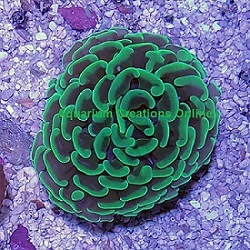
Click For Larger Picture
|
The Branching Hammer Coral, Euphyllia ancora is a large polyp stony (LPS) coral that gets branches like a Torch coral (E. glabrescens). Also called the Euphyllia Hammer Coral or Anchor Coral, its common names are derived from the hammer like, anchor-shaped tentacles. The Hammer Coral polyps are visible throughout the day and night and hide its skeletal base. The polyps may be gold, green, tan, or brown in color, with lime yellow or green tips on the ends of its tentacles that glow under actinic lighting.
Difficulty Moderate
Aggressiveness They have potent sweeper tentacles that it will send out to other corals to keep them from growing too close and will sting anything within reach with its nematocysts. Because of this, you should take care to ensure that your coral has enough room both now and in the future, once the corals in your tank have begun to fill-in the available space.
Water-flow
In terms of water flow, these corals prefer a moderate water flow. Too large a flow will cause the polyps to retract, or be damaged and may also encourage sweeper tentacle issues (see below for more information about that).
Lighting
Since Hammer Corals are found in shallow water regions on the reef it requires moderate lighting levels (from PAR 150-250). T5's, Metal Halides, or LED's can all grow Hammer corals when the proper PAR levels are provided. We recommend a 14-20K color spectrum for best coloration. A warning on using high output lighting; if it will be exposed to brighter lighting it needs to be acclimated to the high output lights in the tank slowly, as it is not usually exposed to intense lighting in the ocean because of its depth. Start out with low lighting, positioning the polyps to face out (versus upwards) and have it shaded by rock or something within the tank. The lighting can gradually get stronger over time, but make the changes very slowly.
Tank Recommendations
A mature, well-fed live rock/reef environment is what is needed, along with some fish for organic matter production, and dissolved organics. Best location is on the bottom of the tank.
Diet and Feeding
It is not necessary to feed a Hammer coral, although they are capable of eating fairly large (by coral standards) meaty foods. The fact that they are biologically able to consume rather large, meaty meals, suggests that feeding should be strongly encouraged. However, Euphylia glabrescens could be kept successfully in a reef tank without any feeding at all, as long as adequate lighting is provided, because their symbiotic zooxanthellae will sustain them. If you want it to grow faster I suggest you feed your corals. All of them. Your Hammer coral will feed nicely on frozen mysis, fortified brine shrimp, rotifers, Cyclopeeze and other similarly sized meaty foods.
Approximate Size: Small: 1 1/4" to 3", Medium: 3" to 4", Large: 4" to 6", XLarge: 6" to 8"
|
|
Thin Branched Bicolor Frogspawn Coral, Australia
Euphylia divisa
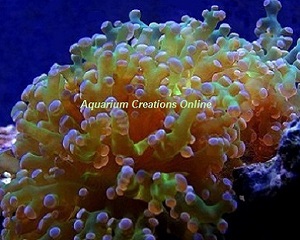
Click For Larger Picture
|
The Bicolor Frogspawn Coral, Euphylia divisa, is a large polyp stony coral species with long, flowing fleshy polyps that extend from a calcified (stony) base. In a moderate water flow, these corals look a bit like a Frogs spawn, which is where they got their common name. The Frogspawn is similar to the hammer coral and the torch coral except that the polyps are branched with round lobes, as can be seen in the images on this page. Frogspawn corals are generally hardy and are a good addition to most reef tanks. They are the perfect blend of stony coral and soft coral, sure to be a pleasant addition to any reef aquascape.
Difficulty Moderate
Aggressiveness The Frogspawn coral has potent sweeper tentacles that it will send out to other corals from growing too close and will sting anything within reach with its nematocysts. Because of this, you should take care to ensure that your Frogspawn coral has enough room both now and in the future, once the corals in your tank have begun to fill-in the available space.
Water-flow
In terms of water flow, these corals also prefer a low-to-moderate flow. Too large a flow will cause the polyps to retract, or be damaged and may also encourage sweeper tentacle issues (see below for more information about that).
Lighting
Since the Frogspawn Coral is found in shallow water regions on the reef it requires moderate lighting levels (from PAR 150-250).T5's, Metal Halides, or LED's can all grow Frogspawn Corals when the proper PAR levels are provided. We recommend a 14-20K color spectrum for best coloration. If it will be exposed to brighter lighting it needs to be acclimated to the high output lights in the tank slowly, as it is not usually exposed to intense lighting in the ocean because of its depth. Start out with low lighting, positioning the polyps to face out (versus upwards) and have it shaded by rock or something within the tank. The lighting can gradually get stronger over time, but make the changes very slowly.
Tank Recommendations
A mature, well-fed live rock/reef environment is what is needed for your Frogspawn Coral, along with some fish for organic matter production, and dissolved organics. Best location is on the bottom of the tank.
Diet and Feeding
It is not necessary to feed a Frogspawn coral, although they are capable of eating fairly large (by coral standards) meaty foods. The fact that they are biologically able to consume rather large, meaty meals, suggests to me that feeding should be strongly encouraged. However, Euphylia glabrescens could be kept successfully in a reef tank without any feeding at all, as long as adequate lighting is provided, because their symbiotic zooxanthellae will sustain them. If you want to feed, they will eat mysis, fortified brine shrimp, rotifers, Cyclopeeze and other similarly sized meaty foods. Larger pieces than a typical mysis is not digestible, and although the animal "accepts" it, it will regurgitate it up later in the night.
Approximate Size: Small: 1 1/4" to 3", Medium: 3" to 4", Large: 4" to 6", XLarge: 6" to 8"
|
|
Green Bubble Coral, Aquacultured
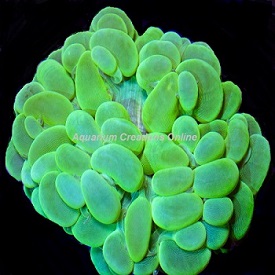
Approximate Inflated Size: Small: 2" to 3"; Medium: 3" to 4";
|
Description
The Aquacultured Green Bubble Coral Physogyra sp. is easy to care for and shows itself off well in any reef aquarium. Needing only gentle water movement and low to moderate light, this is an easy LPS with very few demands. These inflated structures pillow outward from a solid, stony skeleton and prefer to be placed in lower flow environments. This is a tough species, great for entry level coral enthusiasts because it prefers less direct flow and can tolerate a range of lighting and placement options inside the aquarium. Make sure to keep some distance between this species and other corals, as the Bubble Coral has elongated sweeper tentacles that can be aggressive
Difficulty It is easy to maintain in the reef aquarium, which makes it an excellent candidate for the beginning through expert reef aquarist.
Aggressiveness Be cautious, while the bubble does not have toxins, they have the feeding tentacles which are capable of delivering a sting to any coral invading its space.
Water-flow
Does best with gentle water movement.
Lighting
Can do well under lower lighting levels. They can do well under stronger lighting too, as long as they are acclimated to it over a period of time. T5's, Metal Halides, or LED's can all grow Tongue Coral when the proper levels are provided. We recommend a 14-20K color spectrum for best coloration.
Tank Recommendations
A well-feed live rock/reef environment is what is needed for any Bubble Coral, along with some fish for organic matter production.
Diet and Feeding
Best to feed in the evening when the feeder tentacles are out. Feed mysis, rotifers, enriched brine shrimp, Cyclopeeze and other similar sized meaty foods. Try to not feed large pieces since it makes it difficult for the animal to digest such foods and often results in them regurgitating late at night. When this happens, they are not benefiting from the feeding and it can lead to eventual starvation.
Reproduction
It is best to feed them well and keep them happy, then they will form buds which can be harvested and produce quite a few colonies a year! Just be patient. The larger your coral gets, the more "babies" it will give you.
|
|
Super Long Polyping Leather Corals

Approximate Purchase Size when Inflated
Small 1" to 1-3/4", Medium 1-3/4" to 3"
Click For Larger Picture
|
Description
The Super Long Polyping Leather Coral is an aquacultured leather coral of the Sarcophyton family. The polyps of different Leather Coral varieties can have different length tentacles, with stalks of different lengths, or no stalks at all. The Long Polyp Leather Coral is a mushroom shaped leather coral with VERY long flowing polyps. The body is various shades of brown, with long flowing polyps topped in either white or golden. This is a fast growing hardy coral that will adapt quickly to most tank conditions. The Long Polyp Leather coral is cultured by cutting off a piece of the parent's crown and attaching it to a frag plug with thread, string or glue.
Aquacultered
We aquaculture the Long Polyp Leather Corals here at Aquarium Creations, by cutting off fragments of our mother colonies. As they grow they change shape from first a round shaped mini leather that looks like a mushroom then as it grows it takes on a more oblong shape with a more wavy appearance to the leather. After fully opening the top of the leather coral will be covered with very long polys topped by either white or golden starlike polyps.
Care Level
Easy
Aggressiveness
Peaceful
Lighting & Flow Requirements
Long Polyp Leather corals require a moderate level of water flow and a low to moderate level of lighting. Lighting can be Power compacts, T5's, LED's or even Metal Halides. All lighting can grow Leather Corals as long as the proper level of light is provided. If a Par meter is available the appropriate lighting level is anywhere from a Par 100 all the way to a Par 250. Which is a wide range of acceptability. For lighting spectrum use between a 14-20K color spectrum for your bulbs for best coral coloration.
Placement
First allow two weeks time for the Long Polyp Leather coral to adjust itself to its new reef aquarium. If desired you can mount your leather coral using a gel supper glue or a marine aquarium epoxy putty (which is the same as plumbers epoxy putty found in hardware stores). When deciding placement only consider a location providing moderate water current and low to moderate lighting level. Also be certain to leave enough room around your corals that they have room for growth without infringing on another corals growing room or lighting.
Diet and Feeding
Leather corals receive the majority of the nutritional requirements through the process of photosynthesis, which simply means their lighting creates symbiotic algae called zooxanthellae in the body of the leather coral which provides its nutrition. We do recommend providing supplemental food such as micro-plankton, baby brine shrimp, or foods designed for filter feeding invertebrates.
Shedding
Most leather corals go through a natural process of cleansing, once in a while. Leather corals will shrink smaller and the outer skin will look strange as it sloth's itself off, shedding the top layer as it cleanses itself. Leathers may remain closed from just a few days to even a week or longer depending on the aquarium flow and other conditions, but they will reopen larger and even more beautiful than they were before.
|
|
Captive Grown Montipora Digitata 3 Pack

Description:
Montipora Digitata species is a good choice for those hobbyists wanting to make the jump
to small-polyp stony (SPS) corals. Their appearance is soft and velvet-like when their polyps are extended.
This coral also has very unique growth patterns and comes in a variety of colors, adding some nice coral "eye candy"
to your reef.
Captive Grown Montipora Digitata corals are helping the future of the reef aquarium hobby. All of the Digitata packs contain pure
aquacultured specimens, many generations removed from the original wild starter colonies. No tissue or skeleton of the wild specimen
remain. All are third, fourth, fifth and even older generations.
Montipora Digitata for the most part is a branching coral. This means it will
encrust a solid base and then begin growing up toward the light. The thickness of the branches seems to be determined
by how much flow the coral is getting. To understand if your Montipora Digitata is healthy and happy in your reef tank
is to look to see if it has polyp extension and white growth tips. Polyp extension generally indicates that you have good
water quality and the coral is happy. The white tips at the end of the coral indicate that it is getting enough light and
nutrients to grow. In short, M. digitata is a coral that can be appreciated by beginning and advanced hobbyists.
Propagation of the Montipora Digitata group of corals is handled like many other SPS corals and is very simple. Just grab a branch
of the coral and break it off. Once the piece is removed glue it onto a piece of live rock or a frag plug. It's okay to have your coral
out of the water for several minutes. Once the glue is dry place your rock back into the tank.
Lighting Recommendations:
Moderate to high from either T5's, LED's or metal halides.
Water Flow:
Does best with a high level of water flow. The thickness of the branches seems to be determined
by how much flow the coral is getting.
Feeding: Montipora corals are a photosynthetic coral and
do not need to be directly fed. The coral can produce its food from
the lights on your tank. Even though feeding this coral directly is not needed,
you will notice a happier and faster growing coral if you do add some type of
coral food to your tank such as oyster feast or reef chili.
Your Montipora Digitata package contains the 3 corals listed below. If a coral is unavailable a replacement montipora digitata will be chosen based on availability and quality.
(1) Green Parrot Digitata
(1) Orange Popsicle Digitata
(1) Barney Purple Digitata
Approximate Size: 2" to 4"
|
Reg Price $89.99, Sale Price
$79.99
|
Metallic Green Star Polyp Coral
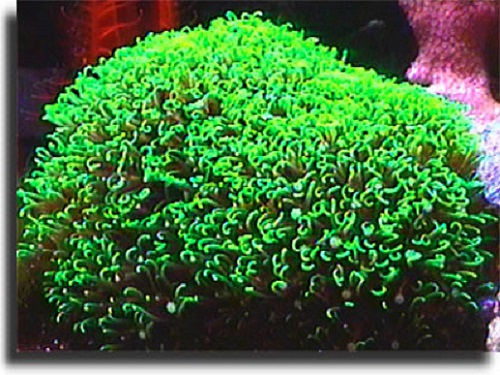
Description:
Very hardy, light and water tolerant,
Metallic Green Star polyps are extremely hardy and can survive
most reef tank conditions. They prefer moderate water motion.
They do well within a wide range of temperature from as low as
72º to as high as 84ºF. Not very aggressive
but they have an encrusting growth pattern, which can lead to
encroachment on its neighbors. Best method to keep this from
happening is just to trim it back as it grows and place the new
growth where you wish to have more beautiful Metallic Green Star
polyps. Most of their requirements are met just from sunlight.
This is called being photosynthetic. It means they do not require
feeding. Since they tolerate a wide range of water flow and light
they can be placed most anywhere in the reef tank. A great beginner
coral and excellent for beginner propagation. Metallic Green
Star polyps are easily propagated by cutting a section of the
purple mat from the main colony using scissors and attaching
it to a piece of live rock with a rubber band or reef glue.
Diet and Feeding:
The symbiotic algae zooxanthellae hosted within their bodies is responsible
for providing the majority of their nutritional requirements
via the algae's light driven process called photosynthesis. They
also will benefit from weekly feedings of micro-plankton or foods
designed for filter feeding coral and invertebrates. As always
we recommend the addition of iodine and other trace elements
to the water.
Approximate Size:
XSmall: 1" to 1-1/2"; Small: 2" to 3-1/2"; Medium: 4" to 5"; Large: 5-1/2" to 7";
|
|
Australia Aquacultured
Acanthastrea Lordhowensis 3, 6, or 12 Pack
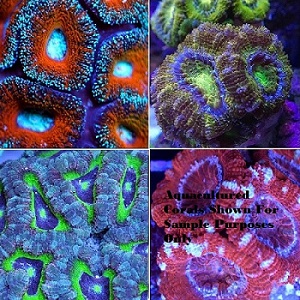
Click For Larger Picture
Approximate Size: 1" to 2"
|
Description
With our Aquacultured Acanthastrea Lordhowensis Package you can start growing your own Acanthastrea lordhowensis corals. Your package includes either 3, 6, 9, or 12 total healed Acans from 1 to 2 inches in size from our large variety of aquacultured pieces. The Acanthastrea lordhowensis, also known as 'The Lord', are the most colorful of the Acanthastrea genus. We have a very large variety of these aquacultured gems. Acan's come in most color combinations from red, purple, green, orange, blue, rust, brown and pale gray, to pale tan. If you order multiple packages all Acan's will be different. Combined they make a beautiful assortment for your reef tank.
The Acanthastrea lordhowensis are great corals and are very easy to care for. They are not at all demanding and they will readily grow new polyps. They do not need to be fed since they use the dissolved organics in the tank for nourishment.
The A. lordhowensis has been propagated in captivity with great success, leading to a variety of colors.
Difficulty Easy to care for, making them an excellent choice for the beginner.
Aggressiveness A semi aggressive coral, Acanthastrea are nocturnal predators and competitively extrude feeder filaments and digest organisms within reach, so be careful with placement and distance between colonies.
Water-flow
It requires slow to medium water flow.
Lighting
It requires low to moderate lighting (PAR 50-150). T5's or LED's can all grow Aquacultured Acanthastrea and lords when the proper PAR levels are provided. Do not use Metal Halides since the they will not fully open. We recommend a 14-20K color spectrum for best coloration.
Tank Recommendations
Provide a moderate light, as strong light will prevent the polyps from opening fully. Water flow should be low as well. Like other members of the Mussidae family, the polyps tentacles come out at night to feed. Provide enough room between each mini colony because they open up large when they have the room.
Diet and Feeding
For best growth and frag recovery time target feed minced meaty foods, liquid micro-plankton and zoo plankton, frozen mysis shrimp or brine shrimp.
|
|
Australian Elegance Coral
Catalaphyllia jardinei

Origin Australia, Pink, Blue or Purple Tips
Click For Larger Picture
|
Description:
The Elegance Coral, Catalaphyllia jardinei is a large polyp stony, called LPS, coral. It's also known as the Purple Tip Elegance Coral, Elegant Coral, or Ridge Coral. Though found throughout the Pacific Ocean Aquarium Creations has found the best healthiest specimens come from Australia. For this reason, we carry Elegance Corals exclusively from Australia. A true beauty, the colorful body is fully open and long tentacles are extended during the day. With a fluorescent green body, and tentacles with either blue, pink, or purple tips, which vary between branched or round and bulbous shapes. The Catalaphyllia Elegance Coral is moderate to maintain in the reef aquarium and makes an excellent coral choice for the beginner to advanced hobbyist.
Difficulty: Moderate
Aggressiveness: Elegance corals are semi-aggressive in temperament and will expand their sweeper tentacles at night well beyond the base. It is important to leave space between the elegance coral and its coral neighbours.
Water-flow:
This coral does well from weak to strong water flow conditions, however strong water flow is beneficial in moving more food to the coral's tentacles.
Lighting:
In order to make the most of its coloration give Low to Medium lighting, (if a Par meter is available a Par level from 30 to 150).
Placement:
Place this one in a soft substrate. The soft substrate is less likely to irritate the fleshy underside of the coral when compared to the rockwork. Clownfish may accept this coral as its host if no anemone is present.
Diet and Feeding:
This coral is photosynthetic. Meaning a good portion of its nutrition comes from the algae zooxanthellae, through the light they receive. At night their feeding tentacles extend on the inside edge of each polyp. If you feed a mixture of frozen meaty foods such as mysis shrimp, Krill, silver sides, and squid they will reward you with better health and fast growth. For continued good health, calcium, strontium, and other trace elements should be added to the water.
|
|
Purple Monster Xenia Cespitularia, Aquacultured
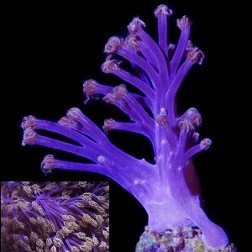
Click For Larger Picture
Approximate Purchase Size when Inflated
Small 1" - 2", Medium 2" - 3", Large 3" - 4"
|
Description
This unusual and beautiful Xenia Cespitularia form is called the Vargas Purple Monster from the original parent colony from the aquarium of author Tony Vargas. It is a beautiful crystalline purple/blue color that really pops when seen top down through the water or illuminated by aquarium lighting. The Cespitularia genus of corals falls under the family Xeniidae and is closely related to Xenia and Anthelia. Its growth form is considerably more robust. Cespitularia species are located throughout Indo-Pacific Area and Red Sea. Colonies are usually found in shallow areas near the shoreline in both clear and turbid water that is somewhat protected from heavy wave action.
Aquacultered
We aquaculture our own Vargas Purple Monster Xenia here at Aquarium Creations, by cutting off fragments of our mother colonies. The Vargas Purple Monster we ship you is many generations aquacultured. This is very important since aquacultured Xenia are hardier than wild-collected specimens and are without the potential to carry sea born infections, or disease to your tank. They have lived there entire life under aquarium lighting and with aquarium type water flow and movement.
Care Level
Moderate
Fragging
Always wait at least 30 days prior to fragging any new corals, giving plenty of time to become very stable in your reef aquarium. To frag, use a brand new razor blade. Find a section that can easily be cut and removed from the existing coral. When placing your cut fragment back into the reef aquarium you can more or less put it where you want it in the aquarium in a crevice and it will usually adhere to the rock in less than an hour. Be aware to choose a location with not to much flow in that spot so it will stay put until it adheres. Occasionally Xenia will release and float around until it finds a home it prefers but this is rare. Usually that only happens when initially placing it. After a few days as long as the Xenia is securely attached to a piece of rock you can move the new Xenia to another location in the tank. We always suggest not moving a new Xenia out of its original aquarium for at least 30 days. This allows the new colony to become strong and healthy.
Aggressiveness
Peaceful
Lighting & Flow Requirements
Cespitularia Xenia requires a moderate level of water flow and a low to moderate level of lighting. Lighting can be Power compacts, T5's, LED's or even Metal Halides. All lighting can grow Xenia Corals as long as the proper level of light is provided. If a Par meter is available the appropriate lighting level is anywhere from a Par 80 all the way to a Par 200. Which is a wide range of acceptability. For lighting spectrum use between a 14-20K color spectrum for your bulbs for best coloration.
Placement
Placement can be any where in the aquarium as long as it receives adequate water flow and lighting levels. Also be certain to leave enough room around your corals that they have room for growth without infringing on another corals growing room or lighting.
Diet and Feeding
Xenia corals receive the majority of their nutritional requirements through the process of photosynthesis, which simply means their lighting creates symbiotic algae called zooxanthellae in the body of the leather coral which provides its nutrition. We do recommend providing supplemental food such as micro-plankton or foods designed for filter-feeding invertebrates.
|
Small $59.99
Medium $79.99
Large $109.99
|
Fat Head Dendro's, Dendrophyllia fistula
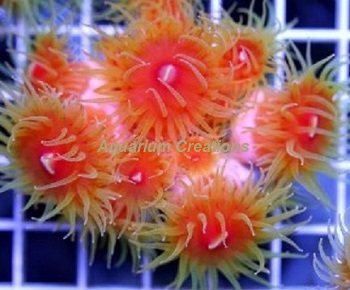
Sold per polyp. If you want a mini colony just order the quantity of polyps.
Click For Larger Picture
Description
With a bright orange body, the fathead dendro provides a nice pop of color and a unique viewing experience thanks to the pale to nearly translucent tentacles. Even though the skeleton of the coral is rigid, a fully extended fathead dendro will sway in the current of your tank and provide nice motion to your tank.
Difficulty Moderate
Aggressiveness Despite the large polyp size, dendrophyllia corals aren’t aggressive at all, but avoid placing them near other corals which can sting them — especially LPS species and their potent sweeper tentacles.
Lighting & Flow Requirements
Dendrophyllia corals naturally inhabit areas of moderate to high flow and this needs to be replicated in the reef tank. Adequate flow brings food to the polyps as well as supplying oxygen and keeping animal tissue clean, ridding it of mucous and detritus. Low lighting is preferred (if a Par meter is available a Par level from 20 to 50).
Placement
They should be put in areas of low lighting and, bearing in mind that dendrophyllia corals are often found in in deep waters often under cliffs or in cave like areas, specimens can also be placed upside down! Being suspended not only lends them a natural look but helps to prevent the accumulation of detritus and sand which can lead to tissue damage. The potential for accumulated sand to harm Dendrophyllia corals means that a sand bed site is risky unless placed this way.
Diet and Feeding
This coral does not have any symbiotic algae residing within its tissue therefore it is 100% dependent upon direct target feeding. It is important to feed your Dendro 3 to 4 times a week and provide a delicate diet mixture of mysis shrimp (just the liquid from the shrimp) no actual shrimp, fish eggs, and sea food morsels. Ideally, one should defrost the mysis shrimp in saltwater and then using a turkey baster gently blow the liquid around the Coral. By providing a consistent diet, you should see your coral thriving in no time with small babies forming. For continued good health, calcium, strontium, and other trace elements should be added to the water.
Reproduction
The Dendrophyllia coral reproduce by budding, forming tiny replicates of itself. Its possible to frag (fragment, or divide) a colony. Use a small Dremal tool to cut sections. However, try to minimise damage to the polyps themselves when fragging a specimen, initially separating them with a craft knife prior to dividing the colony.
$49.99 per polyp.
|
Aquacultured Aussie
Ruby Red & Mint Green Blastomussa Polyps
Blastomussa Wellsi

Click for larger picture
Description:
Aquacultured Ruby Red and Mint Green Aussie Blastomussa coral frags are the healthiest and hardiest on the market! The Blastomussa Wellsi coral is a Large Polyp Stony (LPS) coral with colorful fleshy polyps that extend from a calcareous skeleton. The Blastomussa coral is considered a good starter coral for new reef-keepers as it is a relatively undemanding coral.
Aquacultured:
We aquaculture our own Aussie Blastomussa Wellsi here at Aquarium Creations, by starting with fragments of our Australia mother colonies. The Ruby Red and Mint Green Blastomussa Wellsi we ship you is many generations aquacultured. This is very important since aquacultured corals are hardier than wild-collected specimens and are without the potential to carry sea born infections, or disease to your tank. They have lived there entire life under aquarium lighting and with aquarium type water flow and movement.
Difficulty: Beginner level
Placement:
Place Blastomussa on the bottom or lower portion of the tank. Being a peaceful coral, keep enough space between it and any stinging corals since it cannot defend itself.
Lighting & Flow Requirements:
Blastomussa Wellsi naturally inhabit areas of lower water flow and this should be replicated in the reef tank. Lower to moderate lighting is best (if a Par meter is available a Par level from 30 to 100).
Food and Diet:
The majority of nutritional requirements is taken care of through the symbiotic algae zooxanthellae hosted within their bodies via the algae's light driven process called photosynthesis. They
also will benefit from weekly feedings of micro-plankton or foods designed for filter feeding coral and invertebrates. As always we recommend the addition of iodine and other trace elements to the water.
|
1 to 2 Polyps $35.00
|
Photos are representative of each
species. Each animal is unique and variations should be expected.
Copyright
© 2019, |
|